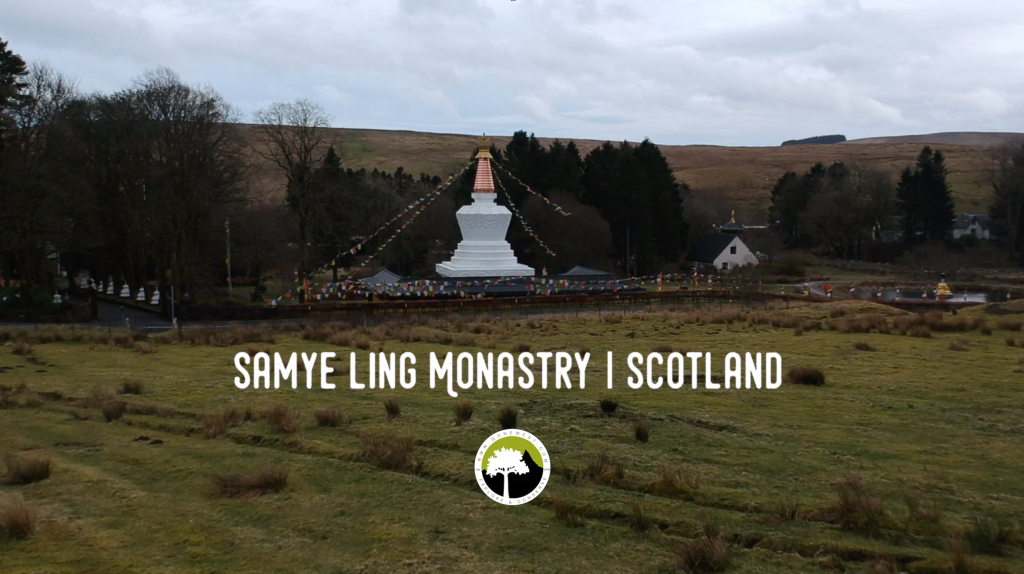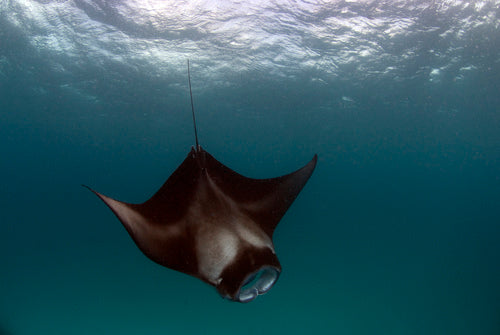RAISED UP ON IT’S HAUNCHES, TEETH BARED, SHOULDERS HUNCHED, THE MASSIVE TIGER WAS READY TO POUNCE.
As I looked around me, I felt like I was in the middle of a surreal dream. Over there, a trio of bicycles leant against each other, over here was a giant hand giving a peace sign, whilst the metal springs of a mattress lay on the floor in between. A huge lotus flower, petals unfolded, stood centre stage, cocooning a sculpture of a beautiful goddess.

PHOTO: LISA COLLINS
All were covered in a coating of brightly coloured corals, with many sporting sea fans, sponges and groups of fish as decoration. I was diving the Biorock Park starting a few meters off the shore of Pemuteran, Bali, North Bali, Indonesia. Biorock was first developed by Professor Wolf Hilbertz in 1979. The German marine architect was invited to Bali by Yos Amerta, a local dive centre owner in Pemueteran, after he discovered Professor Hilbertz’s work on sea walls and thought it might work as an artificial reef. Taking marine biologist Tom Goreau with him, Wolf made his first visit to Pemuteran in 2000.
After increasing damage to coral reefs worldwide, due to weather, rising sea temperatures, dynamite and cyanide fishing, building and marine tourism, attempts had been made to try to build artificial reefs from as early as the 1830’s. The first artificial reefs were made in South Carolina where locals experimented with log huts. However, the wood rotted and deteriorated too quickly before corals could grow on them.
In the 1950’s and 60’s fishermen used concrete blocks, tyres, train carriages, coaches, cars, white goods and even toilets. None of these were particularly successful and took a long time for corals to colonise. Of course, the original and old as time artificial reefs are shipwrecks. Often, completely unrecognisable, wrecks seemed to be the perfect basis on which coral can grow. Many decommissioned vessels are sunk as artificial reef systems, however, they have to be located in a area suitable enough for a huge structure and sunk where they would not damage any existing reefs. Although there has been evidence of fish life moving into their new home almost immediately, it actually takes around 3-5 years for a wreck to be colonised sufficiently by corals and plants to sustain and support a whole wealth of marine species in the same way as a natural reef.
TO NOT ONLY REGENERATE REEFS NEAR TO SHORE, BUT TO INCREASE THE BREEDING AND SPAWNING GROUNDS OF REEF FISH IN PROTECTED WATERS, SOMETHING HAD TO BE DONE.
Wolf Hilbertz had pioneered a a technique of passing electrical currents through salt water. In 1974 he found that salt water minerals would slowly form around an electrode, coating it with a material as strong as concrete. As long as the current flowed, the structure would continue to grow larger and stronger at a rate of 5cm per year. It would also able to regenerate and heal itself if damaged.
Calling this process ‘accretion’, he used the technology to grow low-cost structures in the ocean for developing countries like seawalls. Applying electrical current to submerged conductive structures caused dissolved minerals in seawater to precipitate and adhere to them. Once he met Tom Goreau they began to start thinking about how this could work for coral reefs. Originally steel re-bar was used. It was cheap, easy to weld and found everywhere. Once the simple structures had been made, they were sunk and anchored in around 3-5m. Thick steel mesh wire was then added as another biorock structural material.
Two 12 volt power cables were then attached – one connected to a power supply (positive pole) and the other to the structure (negative pole). Electrochemical reactions raise the ph level around the metal and the mineral accretion formed within 48 hours. They then tied broken live corals to the structure and waited. After 3 months, the corals were naturally attaching themselves to structures and growing.

PHOTO: LISA COLLINS
AT FIRST, THE SUCCESS RATE OF THESE ATTACHED CORALS WAS ONLY 40%, AS THE LOCALS ATTACHING THE CORALS WEREN’T DOING IT PROPERLY OR USING DEAD CORALS.
After extensive training of a small group of locals in the correct corals to attach and the proper way to do it, the success rate in Pemuteran is now 75%. In addition to this, marine biologists who study the structures on a regular basis have found the corals grow faster, they are stronger, are more brightly coloured and have more marine life than natural reefs – a bit like a bionic reef!
Since the year 2000, more than 70 structures have been sunk off the beach in Pemuteran. Most are very healthy and sport a multitude of different skeleton building hard corals. Soft corals and sponges are mostly ‘gardened’ off the structures, as they are much faster growing than hard corals and block the slower growing, but more important reef building hard corals. Once the reef has built up sufficiently, the soft corals, sea fans and sponges are allowed to grow. As the calcium carbonate coating the structures is so similar to the natural reefs substrate, corals freely take to the biorock.
Most of the early structures were either arches or tunnels. A bare mattress was anchored down to see how the coral would take to it, but was the one structure that didn’t work too well, mainly thought because the springs were too tightly packed to allow enough coral to gain a foothold, but also with it being closer to the seabed than the other structures, the flow of nutrients around wouldn’t feed the coral as much.
Biorock structures can be built in any shape or size. Because they can be made of common construction re-bar or wire mesh which is easily found, they can be made very simply by unskilled locals, with just the need of welding equipment. These techniques particularly suit third-world or remote sites, where the reefs have been previously damaged, especially by destructive fishing methods. Local villages can increase marine and eco tourism and thus income, by building artificial reefs, not having to rely so heavily of fishing.
When Tom and Wolf made their first structures in Pemuteran, the power cables kept disconnecting in big storms because of wave movement. They also found triggerfish liked to bite the cables. By getting the whole community involved in helping to nurture and care for these reefs, the main industry of Pemuteran shifted from fishing to ecotourism. In fact, the community has gone on to win many international awards and prizes including the United Nations Equator Prize 2012.
Some of the oldest structures have now been taken off the electrical currents, as their reef skeleton is deemed to be strong enough to support itself. A lot of the original power cables are nearly completely covered in coral growth too.
THE BEAUTIFUL GODDESS SITTING INSIDE THE GIANT LOTUS LEAF IS ACTUALLY THE FIRST STRUCTURE TO BE POWERED BY SOLAR POWER. MORE STRUCTURES ARE BEING PLANNED TO BE SUPPLIED THIS WAY TOO.
The cost of keeping an almost constant power supply (it is shut off for several hours per day to save on electricity), is shared between all the hotels and dive centres in Pemuteran, although Bali Dive Academy is the overseer. Unfortunately, there is no government funding, so an ‘adopt a baby coral’ scheme was founded to help pay for the 4 regular staff who look after the biorock. Visitors can also pay to have their name made out of wire and attached to one of the structures.
Although Pemuteran was the first place to have biorock structures, I had come across several before my visit there this year. In the Lembeh Straits, Lembeh Resort built their own structures. Although not as thickly covered in hard coral, due to the electrical current only being supplied for a short period, and soft coral flourishing on the structures, signs of a heatlhy eco system where none would have been, show testament to the success of these structures.
In Gangga Island near Bunaken, also in Indonesia, they too had built several structures which, again, showed a very healthy ecosystem, although not as much coral growth or marinelife as Pemuteran.

PHOTO: LISA COLLINS
INDONESIA, ACTUALLY HAS THE MOST BIOROCK PROJECTS, IN OVER 6 DIFFERENT LOCATIONS, INCLUDING THE TWO LARGEST REEF RESTORATIONS PROJECTS IN THE WORLD, ONE, OF COURSE, IN PEMUTERAN, AND THE OTHER IN THE GILLI ISLANDS OFF LOMBOK.
Other projects exists in over 20 countries including the Maldives, Caribbean, Seychelles, the Philippines and Thailand.
I had seen the project in Koh Tao located at Japanese Gardens where they also had a underwater buoyancy circuit, whilst doing my Divemaster course in 2012. In conjunction with Save Koh Tao, Big Blue Dive Centre and a consortium of other dive schools launched the biorock project in 2006. It was so successful a newer and larger biorock structure was installed in 2008. For Koh Tao, an island with tens of thousands of divers every year and only a few dive sites, this was particularly helpful in making a brand new dive site.
Because of the mesh like makeup of the structures, they are particularly suitable for storm ravaged reefs, such as in the Caribbean. In Grand Turk, in the Turks and Caicos Islands, two projects were initiated in the shallows at around 5-6m in 2006. Each project had over 1200 corals transplanted onto them. Coral growth was healthy and marine life abundant on the structures. After two major hurricanes, Hanna and Ike, hit the island, it was found that very little damaged was done as the waves passed through the structures. Hurricane Ike was the most powerful hurricane on record to hit Grand Turk, following very quickly in the wake of Hanna. It caused a third of the corals to be lost, and some of the cables displaced, but, in general, the artificial reef survived better than the natural reef.
SWIMMING AROUND THE BEAUTIFUL AND PHOTOGENIC STRUCTURES IN PEMUTERAN,
I not only saw surreal looking biorocks, but ones shaped like a manta ray, a nudibranch, a snail, a seahorse and a dolphin. One of the newest structures was a large wave with a sperm whale riding it, only installed a few weeks earlier. Already a large grouper had found it’s home in the barrel of the wave. A large school of snapper floated above a structure formed like a temple roof, and below a swim platform located above the centre of the dive site for snorkelers who can easily snorkel around this shallow site.
I snorkeled and dive this site many times over the week I stayed in Pemuteran. Each time, I discovered something new, or found a different angle to look at the structures. Seeing new life growing so encouragingly and strongly made me revel in the wonder in the beauty and magnificence of the undersea world.
For more details on Biorock and locations of its projects go to www.biorock.net
I flew to Bali with Singapore Airlines via Singapore.
Stay in the loop
Subscribe to our newsletter.
Listen to the Earth The Gone West Show
For every subscriber we get, we plant a native tree alongside our Plant and Protect project partners and communities across the globe.
Everyone loves to get away, especially after two long years of a global pandemic. From city breaks to countryside getaways, we’re all itching to get out and about and [...]
June 23, 2022
Zero-waste living has been on the rise for quite a fews years. The movement started gaining traction when the public were made more aware of the severity of the [...]
May 15, 2022
As the world is getting back to normal and we’re beginning to travel more freely without restrictions, it’s a good time to start thinking more eco-consciously when planning your [...]
April 30, 2022
We’re sure that you, like us and many other people, are entirely burned out by bad news. Whether it’s bad news about politics, the economy, or the environment, we’ve [...]
April 14, 2022
We’re a few weeks into the Winter Olympics, with people from all over the world participating, attending, and tuning in. The event is all about celebrating people and their [...]
February 17, 2022







